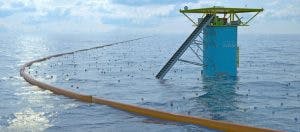
The Ocean Cleanup Technology

The Ocean Cleanup technology that the young Dutch scientist has developed, called Boyan Slat has won several awards, but this time the start of a prototype device tested under the auspices of the Dutch government.
The original 100-meter was installed in the North Sea, 20 km from the coast and it is the “first ocean cleaning system being tested under real conditions.”
The device is made of vulcanized rubber, powered by the kinetic energy of ocean waves and collects garbage passively. In this phase placed sensors that will monitor the device for a chrono.Ta data collected is expected to contribute to the development of a more resilient system to the winds and waves.
The Dutch Environment Minister Sharon Ntouiksma featured «The Ocean Cleanup» as an example that inspires the efforts to address the ever-growing problem of ocean pollution. ”
His ultimate goal is Slat Ocean Cleanup systems to be installed in areas where manifested the strongest ocean currents rotary warming and where the largest volume of plastic waste accumulates discarded at sea.
Chief among them is the “big swirl of Pacific garbage.”
This “vortex” is essentially two huge patches of broken and crushed plastic created in the Pacific Ocean. This is a toxic slurry of plastic with a thickness of ten meters.

According to estimates, more than one million seabirds and more than 100,000 marine mammals and turtles drown each year because of plastic waste either swallow or trapped in them.
But the most dangerous is that this kind of “food” functions like time bomb for humans. Surveys have shown that persistent organic pollutants (POP), such as dioxins or pesticides enter the human body through the marine species and fish oils.
The main goal of the garbage collection is not the first test, but test the resilience of the system to adverse weather conditions in the North Sea, are often worse than those in the Pacific Ocean.
The Slat estimated at 30% probability of the crash of the prototype. But a successful test means that the first fully functional prototype will be able to fall into the sea at the end of 2017.
Source: econews.gr